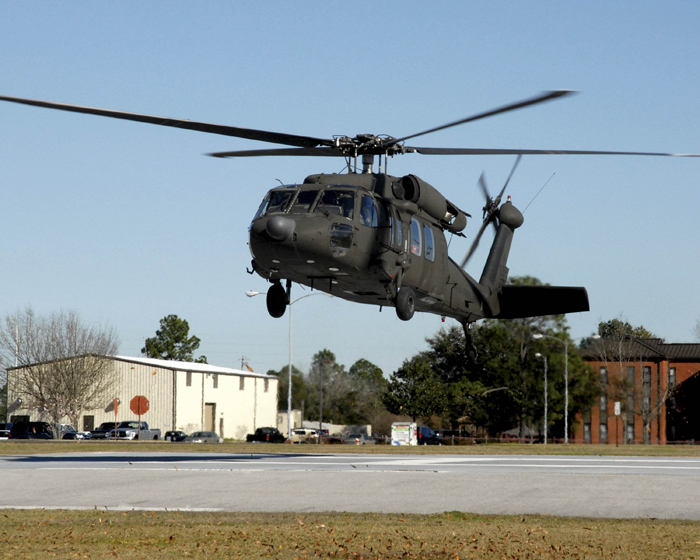USAARL: 50 years of research for Army air, ground Warriors
The U.S. reported a decline in the number of aviation mishaps during fiscal year 2011 (Oct. 1, 2010, through Sept. 30, 2011). The decrease in numbers from 237 mishaps in FY10 to 189 mishaps during FY11 may be due, in part, to the U.S. Army Aeromedical Research Laboratory at Fort Rucker, Ala., which helps save lives by testing helicopter equipment for the Army.
Today, many air and ground Warriors are thankful for USAARL's research accomplishments, which aim to provide medical research in the military operations environment to sustain the Warfighter's performance.
The history began in the early 1960's when then Col. Spurgeon Neel, commander of Lyster Army Hospital at Fort Rucker, shifted the results of wars through his innovation.
Neel recognized that an expanding Army aviation community would need specialized medical and physiological support to help close the gap between Army combat aviation needs and human capabilities, and to protect Aviators from altitude, climate, noise, acceleration, impact, and other stressors in a growing hostile environment.
Therefore, in October 1962, Neel and Maj. Gen. Ernest Esterbrook, then commander of the U.S. Army Aviation Center at Fort Rucker, established the U.S. Army Aeromedical Research Unit with a goal of solving aviation medicine problems.
But, in 1969, as USAARU's involvement in air mobility research grew, the Army re-designated the unit as USAARL, making it a subordinate command under the U.S. Army Medical Research and Development Command.
During the past 50 years, USAARL's research has led to many innovations, such as the development of crushable ear cups, used in flight helmets, to aid in the prevention of basilar skull fractures.
An additional innovation includes the fielding and testing of the communications ear plugs, which provide Aviators with hearing protection and state-of-the-art communications. By using the ear plugs, the Aviator is able to fly extended missions without compromising hearing, safety, or operational effectiveness.
"Every time an aircrew member retires without a serious hearing disability, he can thank USAARL for giving him the best hearing protection available," said Dr. Dennis Shanahan, former USAARL commander.
In more than 50 years, USAARL has been involved with most medical aspects of vehicular occupancy, airworthiness testing, air safety, occupational hazard exposures, and personal protective equipment. In addition, USAARL has researched topics such as vibration, jet lag and fatigue, tinnitus, spatial disorientation, helmets, visors, night vision goggles, seats and restraints, cockpit air bag systems, and fire protective clothing.
In 2006, USAARL developed the noise-immune stethoscope, which enables medical personnel to hear a patient's heartbeat and breath sounds in high-noise environments. In 2012, medics began using the NIS in operational environments. That same year, the lab developed the facial and ocular countermeasure for safety head form to test and evaluate the performance of face and eye protective equipment without using human or animal subjects. FOCUS provides scientific data to improve equipment worn by Soldiers.
Today, USAARL's mission has expanded to cover research in preventing and mitigating Aviator and ground Warrior injuries.
"It is USAARL's promise to the Aviator, the airborne Soldier, and ground Warriors to find medical solutions that reduce health hazards, prevent injury, and protect and improve performance," said Col. Dana Renta, commander of USAARL.
USAARL does this by delivering medical research, testing, and evaluation solutions for air and ground Warriors. The lab conducts medical research to develop return-to-duty standards for Soldiers suffering from neurosensory injuries as well as mild traumatic brain injuries. USAARL also conducts research to determine the effectiveness of life support equipment, and to prevent and mitigate ground crew and aircrew biomechanical injuries.
For example, in 2009, USAARL co-developed the tactile situation awareness system, which uses the sense of touch to provide situation awareness information to pilots. This multifunctional system reduces pilot workload and increases situation awareness, allowing pilots to devote more time to weapons delivery systems and other visual attentive tasks. TSAS also treats patients with balance problems due to traumatic brain injury.
"USAARL enhances product development by ensuring the products are optimized to the Warfighter or that they improve Warfighter safety and survivability," said Shanahan.
Therefore, USAARL has a vital role to play in the development of advanced products that enhance a Warfighter's senses, increase his capabilities, or protect him from a hostile environment.
However, the mission would not be accomplished without USAARL's team of physicians, engineers, scientists, psychologists, pilots, and administrators.
Through the strengths and talents of its personnel, USAARL possesses a unique capability not available in any other Army laboratory.
"USAARL personnel apply their knowledge and skills to make effective and functional systems for the end user ' the U.S. Army Warfighter," said Shanahan. "In doing so, the laboratory has had an immeasurable effect in improving Army systems and has helped save countless lives."
In the future, USAARL will continue to pursue its vision of becoming innovators in aeromedical and operational medical research. This vision will be achieved by USAARL's commitment to Aviators and ground Warriors to find medical solutions that reduce health hazards, prevent injury, and protect and improve performance.















